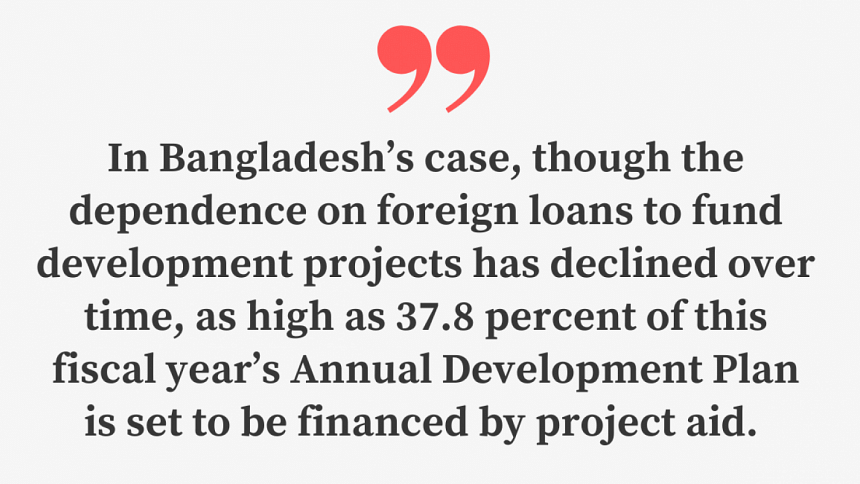How to make development projects more time and cost-effective

In light of the recent debt crisis in Sri Lanka, there is a growing discussion on the funding of development projects. In the context of foreign financing, if one concern is that of debt burden, the other is related to the inefficiency in managing foreign funds. In Bangladesh's case, though the dependence on foreign loans to fund development projects has declined over time – a reflection of which can be seen in the reduced share of foreign funds in the government's deficit financing – as high as 37.8 percent of this fiscal year's Annual Development Plan is set to be financed by project aid. As for the debt burden on the economy, despite concerns, the "risk of external debt distress" of Bangladesh is "low," according to the IMF, with the external-debt-to-GDP ratio hovering around 19.8 percent in 2021.
However, efficiency of the development projects is another matter altogether, with a growing concern especially in terms of implementation of the foreign-financed projects. It is argued that delay at different stages of implementation and a lack of sufficient quality control in particular are adding to both monetary and time costs. Such inefficiency may also create obstacles to get foreign loans in the future.
Though there are structural differences between foreign-funded and domestic-funded development projects, there remain certain common underlying factors that influence the inefficiencies of some of these projects. Broadly speaking, such factors are primarily related to quality service delivery obstructed by bureaucratic complexities, inefficiencies at the project design and selection stages, and deficiencies in project implementation. Foreign donors in certain cases have raised concerns about the sluggishness and incompetence in the preparation as well as submission and approval of development project proposals. The ADB, in the process of committing a USD 20 billion loan for roads and railway projects, recently pointed out the delay in the bidding process resulting primarily from sluggishness in the appointment of a contractor, along with substandard documentation related to the bidding.
In this connection, we must keep in mind that, be it foreign-funded or domestically financed projects, the quality of project implementation strongly depends on the efficiency of the project manager/director. Incompetency of project directors, as well as replacement of project directors within the implementation period of a project, can cause delays. Besides, complexities in land acquisition and settlement can also generate time lags in initiating projects. Often for certain types of projects, particularly those of roads and highways, prohibitive weather conditions can also affect the pace of implementation.

All such factors, relevant in the case of some of the development programmes, are resulting in delays in completion, and as a consequence, the future beneficiaries are being deprived of the benefits of the projects. Time lags in project implementation puts pressure on the development budget as well, as such delays increase project expenses. Delayed projects and the added expenses may therefore divert resources away from crucial areas closely linked to our development priorities. In the case of foreign-financed projects, inefficiencies in project implementation can not only restrict future flow of funds, but may also lead to stricter conditionalities. Given the ongoing global economic crisis, any inefficiency from our side will limit our sources of funds with relatively flexible terms and conditions.
For effective implementation of development projects, finding out the root causes of inefficiencies should be the first step. The importance of regular monitoring and evaluation (M&E) cannot be emphasised enough. Based on such M&E, preferably on a biannual basis, the underlying problems (if any) of the projects should be identified, and more importantly, urgent steps must be taken to resolve them. In this regard, greater transparency and accountability at each stage of project implementation is essential.
Besides, to reduce the time spent at the project preparation stage, detailed background work should be carried out in advance. In addition, greater care must be taken to prepare the relevant documents associated with project design. If required, concrete feasibility studies must be undertaken and the recommendations and suggestions of those studies should be considered during project implementation.
In the case of foreign loans, not only internal efficiency, but a careful assessment of the modalities of loans is also needed so that the most prudent choice is made in fund selection. In this regard, we must not miss the "low hanging fruits," that is, the opportunities of smaller funds with fewer conditionalities and relatively low interest payments. Finally, we must keep in mind that the credibility of development projects lies not on spending money and their completion within the stipulated time frame, but also on what that money has attained. Therefore, in addition to quantitative yardsticks, it is crucial that the projects are evaluated on the basis of the country's performance in accomplishing its development goals.
Dr Sayema Haque Bidisha is a professor at the Department of Economics of Dhaka University, and research director at the South Asian Network of Economic Modeling (Sanem).

 For all latest news, follow The Daily Star's Google News channel.
For all latest news, follow The Daily Star's Google News channel. 






Comments